 |
Thermal container with integral unit - rear |
 |
| Thermal container - side and end with integral unit |
Depending on container quality, the entire outer skin may be appropriately insulated, thereby reducing the internal dimensions of the container. According to ISO 1496/2, the internal width must amount to 2200 mm. The container (reefer) floor is generally made of T-shaped aluminum profiles and is also known as a T-grating. The floor is strong enough to allow access by forklift trucks. The type code distinguishes between thermal containers according to type of refrigeration unit and/or coefficients of heat transmission (k values). The temperature of insulated containers may be controlled by external refrigeration units.
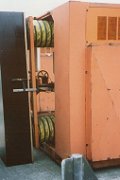 |
 |
 |
| Mobile refrigeration unit, in this case in stationary use | ||
 |
 |
Mobile refrigeration unit, for stationary use |
DIN EN ISO 6346, January 1996 lists thermal containers under Code R, namely:
- mechanically refrigerated under group code RE and type code R0
- mechanically refrigerated and heated under group code RT and type code R1
- self powered mechanically refrigerated under group code RS and type code R2 and
- self powered mechanically refrigerated and heated under group code RS and type code R3
 |
 |
| 20' x 8'6" thermal container, mechanically refrigerated/heated | |
 |
 |
| 40' x 9'6" thermal container, mechanically refrigerated/heated |
Code H of the same standard covers refrigerated and/or heated thermal containers with removable equipment, with group code HR applying to:
- refrigerated and/or heated with removable equipment located externally, coefficient of heat transfer K = 0.4 W/(m² x K), type code H0
- refrigerated and/or heated with removable equipment located internally, type code H1
- refrigerated and/or heated with removable equipment located externally, coefficient of heat transfer K = 0.7 W/(m² x K), type code H2
Group code HI covers insulated containers, namely:
- Type code H5 = insulated, coefficient of heat transmission K = 0.4 W/(m²·K)
- Type code H6 = insulated, coefficient of heat transmission K = 0.7 W/(m²·K)
These containers also resemble standard containers externally, but inside they have a heat-insulating lining, generally of polyurethane foam-based insulating material. Their wall thickness of 50 - 100 mm reduces stowage space a little compared to normal containers. The insulation is intended to protect the cargo from over-rapid temperature variations. If lower temperatures or refrigeration are required, refrigerants may be added. Ice is seldom used nowadays, since it requires special ice boxes; instead, dry ice is often used. Another method is to vaporize liquefied gases. Such containers are used for the most part to carry heat-sensitive cargoes.
Insulated containers and refrigerated containers may also be used without refrigeration or heating. Since temperature variations in the container are delayed relative to the external temperature, using such containers can be entirely appropriate for certain goods.
Refrigeration and/or heating may be achieved by:
- compressors directly driven by electrical motors
- compressors directly driven by internal combustion engine
- externally generated cooling or heating air
The electrical power required for driving refrigerating/heating machines is supplied by on-shore or on-board power supply systems or by a separate generator driven by an internal combustion engine, diesel engines mostly being used for this purpose. A distinction is drawn between fixed generators and so-called clip-on generators, which are only fitted on a temporary basis.
 |
Integral refrigerating/heating machine for connection to on-shore or on-board power supply system |
Fixed refrigeration units (integral units) reduce the useful length and payload of containers.
 |
 |
| Clip-on units for temporary fitting to thermal containers | |
Clip-on units increase the overall length of the containers. These heating/refrigerating machines are individual units which may be stored on shore or on board and temporarily attached to the end walls of containers. Each apparatus may be individually adjusted and does not affect the cargo space atmosphere for other containers. Supply air is input at the bottom and return air is extracted at the top.
 |
 |
 |
| Openings for supply and return air in an external unit | ||
Such containers are also known as "porthole containers", the name arising from the similarity between these openings and the round ships' windows known as portholes.
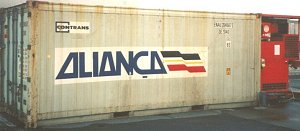 |
 |
| Thermal container/insulated container with externally fitted supply device | Supply device for a thermal container - detail |
Externally generated cooling or heating air may be supplied via on-shore or on-board central refrigeration systems. Containers supplied by this system also have two openings in the end wall for the supply and removal of cargo space air subject to artificial temperature control.
The term Conair container is a brand name often used for "insulated container".
Open-top containers are suitable in general for all types of general cargo but especially for heavy, overheight cargo. Since their roofs are openable, they may also be packed from above. They have doors at least at the rear and their roofs are openable or removable. The roof covering consists either of a tarpaulin supported by roof bows or a solid, fully removable hard-top. Containers with the latter type of roof covering are known as hard-top open-top containers.
 |
Open-top container with tarpaulin and roof bows |
 |
 |
| Above and right: Hard-top open-top containers |
 |
Cover removed from a 20' hard-top open-top container |
| So that it is possible not only to introduce cargoes from above but also to load overheight cargoes through the doors, some containers have removable or swing-out top members or top door rails. This also facilitates packing using lifting gear at floor level. |  |
| Open-top container with top member removed |
The roof bows of an open-top container serve both to support the tarpaulin and to stabilize the whole container. Such containers are therefore also made wholly of steel, so that the structure is still sufficiently stiff despite the absence of a roof. If overheight cargoes are carried, the stabilizing effect of the roof bows is absent. In some cases, therefore, it would be sensible to investigate whether it would not be equally possible to use flatracks or indeed whether that would not be the better solution from the point of view of cargo securing.
Half-height open-top containers are open at the top, as their name suggests. There are two types in existence: either completely open or with a tarpaulin and roof bows. The rear door may often be folded down and used as a ramp.
 |
 |
| 20' and 40' half-height open-top containers, with and without cover | |
DIN EN ISO 6346, January 1996 lists open-top containers, abbreviated as OT, under Code U. The group code for all such containers is UT. The following types are distinguished by the type codes indicated:
- U0 - Opening(s) at one or both end(s)
- U1 - Opening(s) at one or both end(s) plus removable roof in end frame
- U2 - Opening(s) at one or both end(s) plus opening(s) on one or both sides
- U3 - Opening(s) at one or both end(s) plus opening(s) on one or both sides plus removable top members
- U4 - Opening(s) at one or both end(s) plus opening(s) on one side plus full openings on the other side
- U5 - Full, solid side and end walls (no doors)
 |
 |
| 20' x 8' x 4'3" Half-height open-top - external and internal view | |
With this container, the rear end wall (at the front in the left-hand picture) can be folded out and used as an access ramp for forklift trucks. A warning is attached:
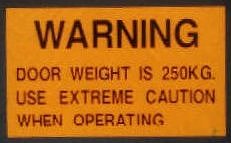 |
Warning about the "ramp" of a half-height open-top container |
The old, but still valid, number combination 4351 would today be replaced by the code 42U3.
 |
 |
| Two OTs: each with rear doors and removable top members | |
Platforms and flatracks are also known in common parlance as open containers. Although such containers may have special equipment, such stanchions, fold-down end walls, lashing equipment etc., they are often described in specialist literature as containers without additional equipment.
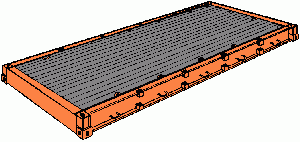 |
Platform: 20' long, 8' wide and 1'1¼" high |
Platforms consist of reinforced container floors with sheet steel or planking. A large number of lashing points are provided for cargo securing; these may be welded-on or recessed lashing lugs or rings, or lashing bars attached to the outsides of the side rails.
| Two 20' platforms 1'1¼" high |  |
If agreed with the shipping companies, several platforms may be combined to form larger loading areas for carrying oversize goods. Acceptance and delivery then require special attention and coordination of operations between the ship's command, shipping companies and terminal operator is recommended. When empty, platforms can be stacked into piles to save space during transport. Since loaded platforms are not stackable, they are loaded on board ship as the top layer of a hold or deck stack. If a ship's cell guides are equipped with flaps, any stowage space can be used. 20' platforms are generally 335 mm (1'1¼") high, while 40' platforms are generally 610 mm (2') high). There are 40' platforms with gooseneck tunnels at both ends.
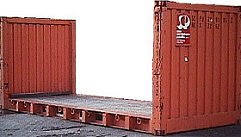 |
Flatracks, also known as flats, consist of container floor and end walls. Flatracks with folding or collapsible end walls or end frames are commonly known as collapsible flats or collapsible flatracks. |
| 20' flatrack with fixed end walls |
 |
Flatracks are also known as "open-top open-sided containers". |
| 2.50 m wide 20' flatrack, one of the inland containers provided by DB (German Railroads) |
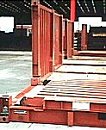 |
 |
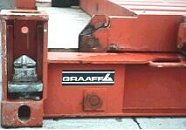 |
| 20' collapsible flatracks, erected and collapsed | ||
The advantage of collapsible flatracks is that several unloaded flats can be stacked on top of one another to save space during transport. For cargo securing purposes, the flats are equipped with lashing bars, lugs or hooks of appropriate strength. Stanchion pockets and insertable stanchions are often provided. If agreed with the carriers, a number of flatracks may be combined together so as to be able to transport particularly large items of cargo.